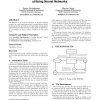10 search results - page 2 / 2 » The Self-Organization of Interaction Networks for Nature-Ins... |
GECCO
2005
Springer
14 years 1 months ago
2005
Springer
This article describes a mathematical framework for characterizing cooperativity in complex systems subject to evolutionary pressures. This framework uses three foundational compo...
GECCO
2006
Springer
13 years 11 months ago
2006
Springer
The purpose of this work is to propose an immune-inspired setup to use a self-organizing map as a computational model for the interaction of antigens and antibodies. The proposed ...
WSC
1998
13 years 8 months ago
1998
Informational Macrodynamics (IMD) presents a unified informational systemic approach with common information language for modeling, analysis and optimization of a variety of inter...
HCI
2009
13 years 5 months ago
2009
We have explored using neurophysiologic patterns as an approach for developing a deeper understanding of how teams collaborate when solving time-critical, complex real-world proble...
GECCO
2006
Springer
13 years 11 months ago
2006
Springer
The application of network analysis to emergent mating topologies in spatially structured genetic algorithms is presented in this preliminary study as a framework for inferring ev...

